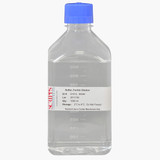Apoferritin, Human, H+L Chains, Recombinant
- SKU:
- 90659-0001
- Catalog Number:
- F1021
- Part Number:
- 90659
- Physical Form:
- Clear liquid
- Purity:
- ≥95% by SDS-PAGE
- Protein Content:
- 1.0-5.0 mg/ml
Click to inquire about Bulk Pricing Discount for Recombinant Apoferritin, F1021
This preparation of Recombinant Apoferritin is the multi-subunit form of Ferritin, composed of heavy and light chains. It does not contain any iron atoms and is, therefore referred to as Apoferritin, rather than Ferritin. It is produced in E. coli and is provided as a liquid in 10 mM Tris, 150 mM Sodium Chloride, 0.02% Sodium Azide, pH 8.0. Protein content is determined by immunoassay on a Centaur CP analyzer and by the Lowry Protein Assay (BSA standard).
Product Specifications:
Literature:
Ferritin is a water-soluble, iron storage protein found in most animal cells. Its spherical structure is composed of 24 subunits and contains a 7-nm cavity with a ferric oxyhydroxide crystalline core that is capable of storing approximately 4500 iron atoms. Iron passes in and out of the ferritin cavity through 0.7-1.0 nm pores in the outer shell. Up to 25 ferritin isoforms are thought to exist, composed of various combinations of the two primary subunits, H and L, which have molecular weights of 21,000 and 19,000, respectively. Ferritin rich in the H subunit is found in heart muscle, red blood cells, lymphocytes, and monocytes, while that rich in the L subunit is found in the liver, spleen, and placenta. Ferritins composed of a higher proportion of H subunits are more acidic (pI as low as 4.8) than the isoforms containing a higher proportion of L subunits (pI 5.3-5.8) Human serum ferritin is primarily composed of the L subunit, which also corresponds with a lower iron content. Ferritin isolated from the liver and spleen contain >12% iron by weight.
Ferritin is the body's primary iron source for hemoglobin synthesis; only hemoglobin itself accounts for more of the body's total iron content. When serum iron levels decrease below normal levels, ferritin readily releases its iron stores for use. Serum levels of ferritin are known to closely parallel tissue ferritin levels and are, therefore, indicative of body iron content. As such, clinical tests for ferritin serum levels are used to detect and manage iron-related disorders, such as iron deficiency anemia and iron overload. High levels of serum ferritin are associated with disease severity in Covid-19 patients, in addition to various malignant diseases and tissue damage.




